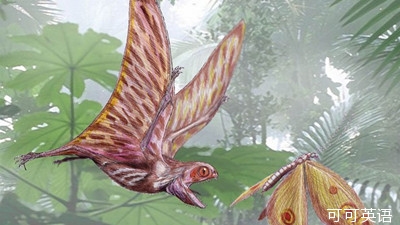科學技術
Ancient animal behaviour
遠古動物行為
Jurassic lark
侏羅紀雨燕
How the pterosaur caught its supper
翼龍是如何逮到晚餐的
PALAEOETHOLOGY, working out how long-extinct animals behaved, is a subject whose practitioners can never, definitively, be proved right.
古行為學,作為一門研究那些早已滅絕的動物的行為的學科,其研究者永遠不可能證明自己的理論是確鑿無誤的,
But that does not stop them trying.
但這一點從來沒有阻止過他們對真相的探索。
 The latest effort, to be presented later this month to the International Symposium on Pterosaurs in Rio de Janeiro, is an attempt by Michael Habib of the University of Southern California, in Los Angeles, and Mark Witton at the University of Portsmouth, in Britain, to work out how one of the most peculiar of the flying reptiles of the Jurassic earned its living.
The latest effort, to be presented later this month to the International Symposium on Pterosaurs in Rio de Janeiro, is an attempt by Michael Habib of the University of Southern California, in Los Angeles, and Mark Witton at the University of Portsmouth, in Britain, to work out how one of the most peculiar of the flying reptiles of the Jurassic earned its living.
本月晚些時候,將于里約熱內盧舉行的國際翼龍目研討會將展示該領域最新一項研究成果,南加州大學的Michael Habib和普利茅斯大學的Mark Witton進行了該項研究,目的在于弄清楚侏羅紀最神奇的飛行類爬行動物之一是如何捕捉食物的。
Anurognathus and its relatives have been known for 90 years.
蛙嘴龍及其近親為人類了解已有90年。
They were the size of swifts and until now it had been thought that, like swifts, they chased around the sky after insects—a technique known as hawking.
它們體型如雨燕般大小,直到今天,人們一直認為它們像雨燕一樣在天空中到處疾飛追逐昆蟲—即一種被稱為飛行捕食的攝食策略。
Dr Habib and Dr Witton believe this is wrong.
兩位博士Habib 和Witton認為這種理論是錯誤的,
They suspect instead that Anurognathus sat in wait for its prey, and then sallied forth to intercept it like a surface-to-air missile.
他們猜想蛙嘴龍反而是靜待獵物,然后像地空導彈一樣突然騰空截擊。
They came to this conclusion by comparing Anurognathus with 36 birds and 20 bats from the Smithsonian Institution in Washington, DC.
在將蛙嘴龍與取自斯密森學會博物館的36種鳥和20種蝙蝠進行對比后,Habib和Witton做出這一推論。
Using a mix of computerised tomography and mundane measurements with callipers, they assessed the lengths, widths, thicknesses, densities and bending potential of the bones of the modern animals and compared them with those gleaned from Anurognathus fossils.
他們綜合了計算機斷層攝影術和使用卡鉗的普通測量方法,分析評估了現代動物骨骼的長度,寬度,厚度,密度及彎曲度可能性,并將它們和從蛙嘴龍化石中搜集到的數據進行對比。
Anurognathus's mouth, they found, was similar to the mouths of nightjars, which also sally after prey.
他們發現,蛙嘴龍的嘴與夜鷹相似,后者也是突襲獵物的。
Moreover, the pterosaurs' legs and wings were stronger than those of any comparable bird or bat, reinforcing the idea that they could leap rapidly into the air.
另外,翼龍的腿和翅膀要比任何可以相提并論的鳥類和蝙蝠都要強壯,這一點強化了它們可以迅疾騰空的觀點。
Their conclusion was that Anurognathus did indeed feed by sallying—and probably more effectively than any living creature.
兩位博士Habib和Witton的結論是,蛙嘴龍的確是突然騰空襲擊獵物的—而且它們的狩獵有可能比任何生物都要更高效。
 The latest effort, to be presented later this month to the International Symposium on Pterosaurs in Rio de Janeiro, is an attempt by Michael Habib of the University of Southern California, in Los Angeles, and Mark Witton at the University of Portsmouth, in Britain, to work out how one of the most peculiar of the flying reptiles of the Jurassic earned its living.
The latest effort, to be presented later this month to the International Symposium on Pterosaurs in Rio de Janeiro, is an attempt by Michael Habib of the University of Southern California, in Los Angeles, and Mark Witton at the University of Portsmouth, in Britain, to work out how one of the most peculiar of the flying reptiles of the Jurassic earned its living.










